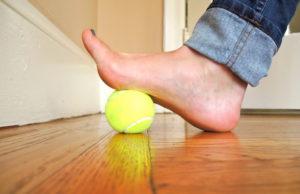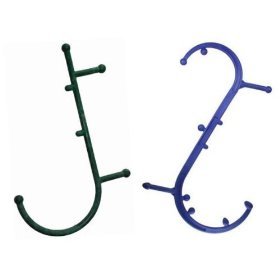Why do you want to massage yourself?
On my first client information post, I discussed resisted stretching for “tight” muscles. This is most effective when muscles are stuck in old patterns governed by the nervous system. Muscles may also be stuck in a position due to a mechanical issue – the muscles and connective tissue may be dehydrated and stuck together (people often call this a “knot”), or you may have a trigger point. A trigger point is a sensitive spot within a band of taught tissue that often refers an achy pain to other areas, and may inhibit proper contraction and relaxation of the muscle. A therapeutic massage professional can help you pinpoint these spots with precision, find connections you didn’t know existed, or help you discover underlying causal patterns.
However, there is a lot you can do to address specific points on your own! If you feel pulled to work out your muscles directly, go for it. This post shares some guiding principles and common tools to massage yourself at home.
GENERAL PRINCIPLES
Where should you work?
Trust yourself. If a whole area is bothersome, generally finding the most sensitive point will be most efficient. This may or not be a spot with a “knot”. If it feels too sensitive (and gets your whole body going) it is best to start nearby and work your way up to it.
Pressure and timing
When you are on a sensitive point, stay between a 4-6 on a scale from 1-10 in intensity. Often, people start off too aggressively – think about having a conversation with this area of your body. If you are shouting at your shoulder, will it relax? You want to be direct and clear, but you also want to listen.
Hold the point for around 30 seconds to 3 minutes and keep breathing. Once the sensation backs off to a 1-2 on the scale you can stop or do another round of deeper pressure at your newly calibrated 4-6 intensity.
How should it feel?
Working out specific spots is often intense. Make sure if it hurts that it feels productive and satisfying. If you find yourself not breathing and resisting against the sensations, back off to the point where you can breathe deeply and relax. Less is more. Play with it, and discover how your body responds best.
How often?
It depends. It may range from a few times total, to a number of times a day, to on and off over a week or two. Be aware of not overdoing it, however you are not likely to cause damage beyond some soreness if you are really listening to yourself. If you are not able to resolve the issue with self massage in a timely way, there is likely something else going on and it may be best to try another approach.
RECOMMENDED TOOLS
Try your own fingers, thumbs, knuckles, fist or elbow
A lot of issues you can address directly with your own body. Experiment with what feels good! Just be careful you don’t stay in awkward positions for too long and stress other parts of your body. If you want to massage a hard to reach place, you may want to use a tool instead.
Use a ball
 My favorite self-massage tool is one you probably already have laying around. Tennis balls are the most common and cheapest. Generally, you want to pin the ball between your body weight and a hard surface like the floor or the wall. You can even put two tennis balls in a sock. Try rolling on them alongside your spine or resting on them at the base of your head. Lacrosse balls are a popular cheap option that is a bit firmer, but there are many massage specific products for sale out there. Basically, if you have a few different balls of different sizes and densities, you should be able to target most any point you want.
My favorite self-massage tool is one you probably already have laying around. Tennis balls are the most common and cheapest. Generally, you want to pin the ball between your body weight and a hard surface like the floor or the wall. You can even put two tennis balls in a sock. Try rolling on them alongside your spine or resting on them at the base of your head. Lacrosse balls are a popular cheap option that is a bit firmer, but there are many massage specific products for sale out there. Basically, if you have a few different balls of different sizes and densities, you should be able to target most any point you want.
 Try a cane
Try a cane
These are great tools that look like a curved stick with various protruding knobs. Canes use leverage for precise and satisfying pressure without too much effort. They allow you to massage hard to reach spots like the middle of your back. They come in a variety of sizes and shapes.
Using rollers
Rollers are best for general deep massage rather than specific point work. Foam rollers are popular, especially with athletes. You can also find rollers made of other harder materials, with ridges or knobs, or small plastic stick rollers. I recommend starting out with a softer foam roller if you are new to the practice or not regularly active.
There are lots of opinions on when and how to roll. I personally use a foam roller when I feel tension in a large muscle area, and I don’t roll all that often. I have found success rolling along my mid back, hip flexors, glutes, and quads. Make sure you avoid putting pressure on your your joints and bones including your spine! I like this article for more information to help you avoid common foam rolling mistakes.
Recruit another pair of hands!
A lot of this stuff is intuitive. We often know what our bodies need if we really listen, but we are taught that we don’t know. I know this is about self massage, but part of taking care of yourself is asking for support from others. Recruit a friend, partner, lover, roommate, or family member. You will have greater success if you give them clear feedback on location, duration, and pressure.
HAVE FUN
Enjoy and appreciate the time you spend caring for yourself. It doesn’t need to be a chore and it doesn’t need to hurt, in fact it can be deeply pleasurable or relieving. There is a lot of discomfort that we regularly put up with that is easily addressed and prevented. Give yourself this gift and own your ability to be responsible for how your body feels and moves.